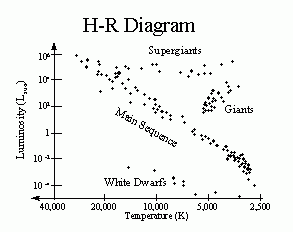
H-R diagrams are very useful tools, so I'll be referring to them throughout the entire first half of the course.
Astronomy 162: Professor Barbara Ryden
 max,
max, max = wavelength of
maximum emission (measured in meters).
max = wavelength of
maximum emission (measured in meters).Using the above formula, we can compute the temperature of a star's photosphere from the wavelength at which it emits the maximum amount of light.
The temperature of a star's photosphere can also be deduced from its color. Cool stars (such as Betelgeuse, which has a surface temperature of T = 3500 Kelvin) emit more red and orange light than blue and violet light. Thus, cool stars are red. Hot stars (such as Rigel, which has a surface temperature of T = 15,000 Kelvin) emit more blue and violet light than red and orange light. Thus, hot stars are blue.
One way of classifying stars is by their temperature; stellar temperatures run from about 2500 Kelvin to about 50,000 Kelvin. Another way of classifying stars is by using the notorious OBAFGKM spectral classes. They are `notorious' because the ordering of the spectral classes, from ``O'' to ``B'' to ``A'' to ``F'' to ``G'' to ``K'' to ``M'', doesn't follow in logical alphabetical order. Initially, in the 19th century, the spectral classes represented a purely empirical method of sorting stellar spectra, based on the strength of their hydrogen absorption lines.
Useful mnemonic: Oh Be A Fine Guy, Kiss Me.
(If you prefer: Oh Be A Fine Girl, Kiss Me.)
The OBAFGKM spectral sequence has recently been extended to include class L (objects with temperature around 2000 Kelvin) and class T (with temperature less than 1300 Kelvin). Objects of spectral type L and T are not (technically speaking) stars at all, since they are not hot enough for fusion to occur in their cores. They are called ``brown dwarfs'' rather than ``stars''.
For aficionados of stellar spectra, more details and illustrations are available from Professor Richard Pogge's description of Characteristics of the Stellar Spectral Types.
Another way of classifying stars is by LUMINOSITY.
Make a plot - temperature on the horizontal axis (hot stars to the
left; cool stars to the right) and luminosity on the vertical axis
(dim stars at the bottom; bright stars at the top). This plot
is called the Hertzsprung-Russell diagram (or H-R diagram, for short)
after its inventors. An example of a Hertzsprung-Russell diagram
is given below.

H-R diagrams are very useful tools, so I'll be referring
to them throughout the entire first half of the course.
About 90% of all stars are on a narrow diagonal band running from the upper left corner of the H-R diagram (hot, luminous stars) to the lower right corner (cool, dim stars). This diagonal band is called the MAIN SEQUENCE.
The Sun is on the main sequence.
Giants are more luminous than a main sequence star of the same temperature. Giants tend to be relatively cool (T < 6000 Kelvin) but luminous (L = 100 to 1000 Lsun). Giants are rare, but easy to detect, because of their high luminosity.
Supergiants are even more luminous than giants. Supergiants can have any temperature, but they are always VERY luminous, with L = 100,000 to 1,000,000 Lsun. Supergiants are VERY rare, but are VERY easy to detect, because of their VERY high luminosity.
White Dwarfs are less luminous than a main sequence star of the same temperature. They are called WHITE dwarfs because they are fairly hot; white-hot, in fact, with temperatures of T > 5000 Kelvin. The are low in luminosity, with L = 0.0001 to 0.01 Lsun. White dwarf are fairly common, but they are difficult to detect, because of their low luminosity.
Take a random sample of 1,000,000 stars from our galaxy. In this sample, you will find, on average:
Prof. Barbara Ryden (ryden@astronomy.ohio-state.edu)
Updated: 2003 Jan 15
Copyright © 2003, Barbara Ryden